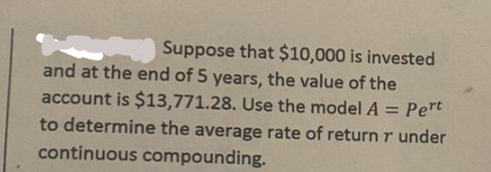Full solution
Q. Suppose that is invested and at the end of years, the value of the account is . Use the model to determine the average rate of return under continuous compounding.
- Isolate : We have the formula for continuous compounding: . Here, , , and years. We need to find .
- Calculate : First, divide both sides of the equation by to isolate . So, .
- Simplify to : Now, take the natural logarithm () of both sides to get rid of the exponent..
- Solve for : Since simplifies to , we have .Calculate using a calculator..
- Calculate : Finally, divide both sides by to solve for ..
- Calculate r: Finally, divide both sides by t to solve for r..Calculate r. or .
More problems from Compound interest
QuestionGet tutor help
QuestionGet tutor help
QuestionGet tutor help
QuestionGet tutor help
QuestionGet tutor help

